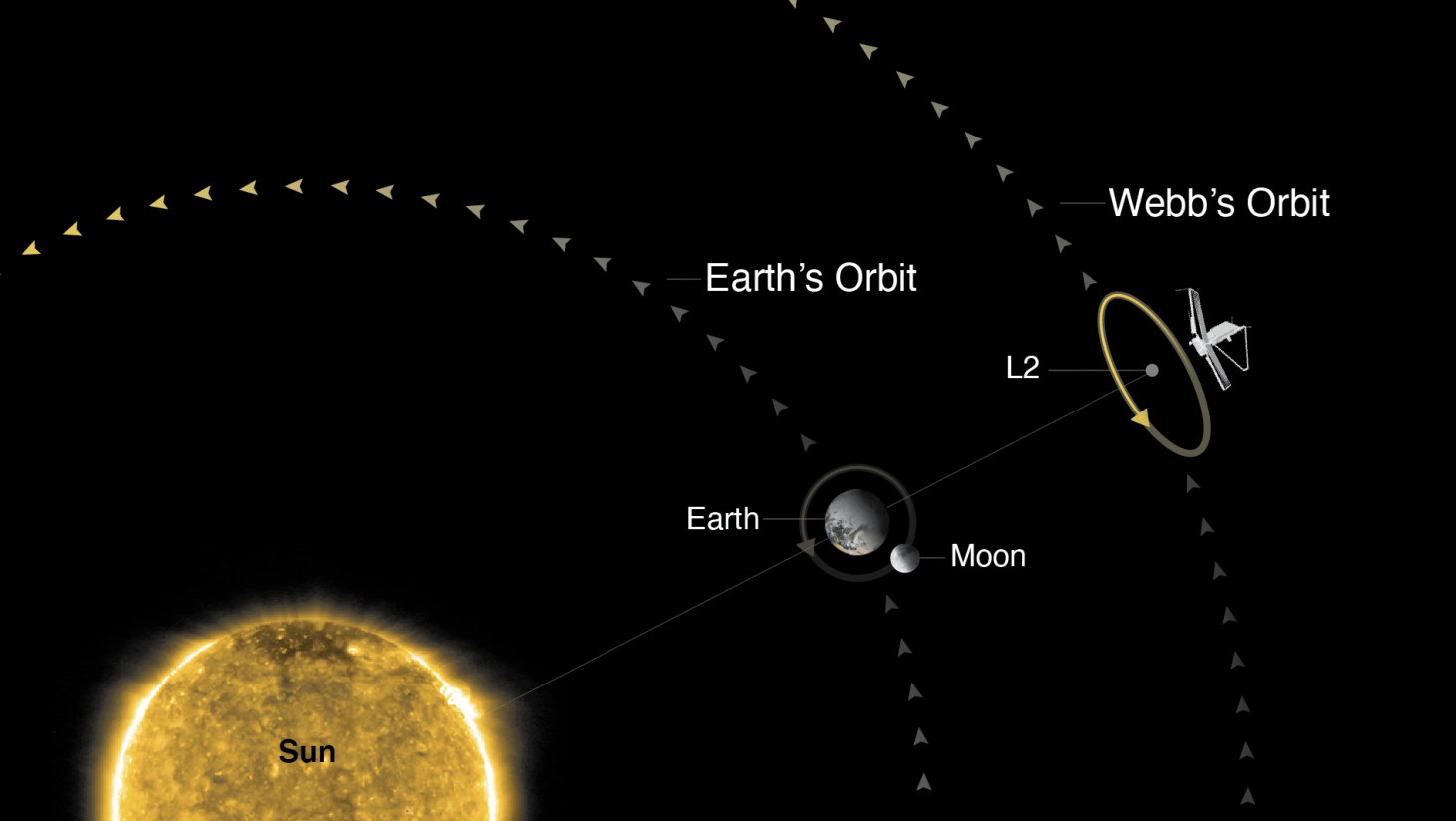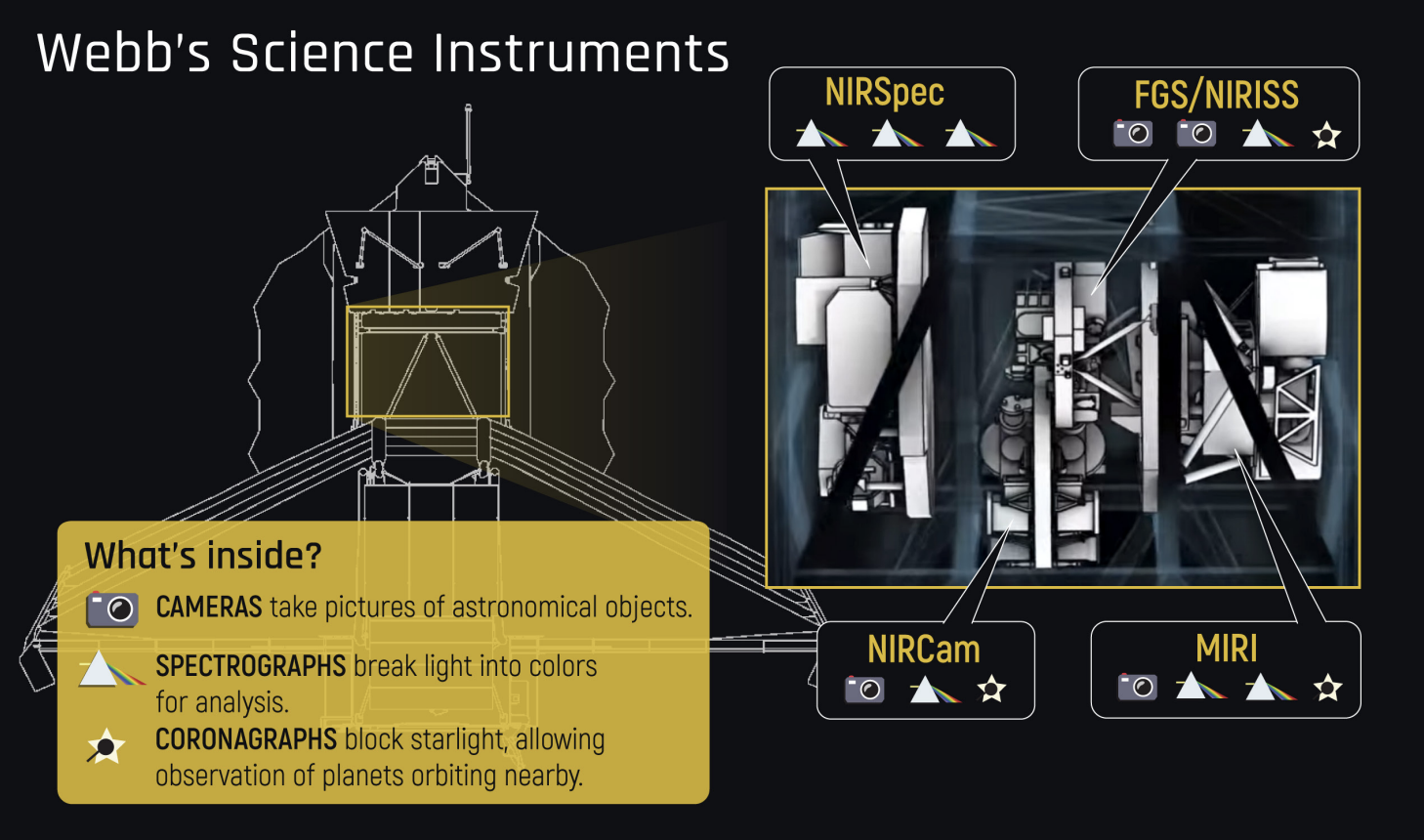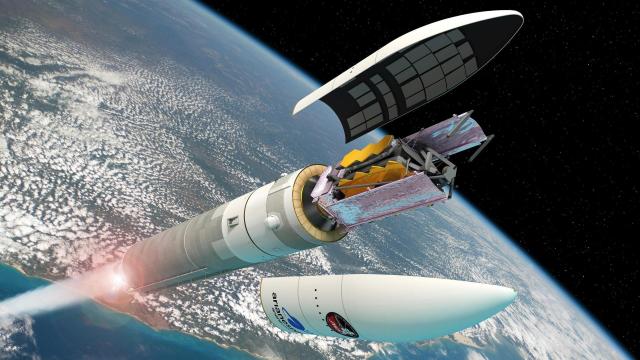The Webb Space Telescope, after years of delays, has finally reached the launch pad. It’s a momentous occasion, but the observatory still needs to go through a complex and unprecedented commissioning process that will require a nerve-wracking six months to complete. The hard part, it would seem, is still to come.
Developed by the American, European, and Canadian space agencies, and with help from private contractors such as Lockheed Martin, Webb has been described as the “most complex and powerful telescope ever built.” With its infrared capabilities, Webb will hunt for ancient stars and galaxies, study the formation of stars and exoplanets, and search for life in the Milky Way. The space telescope has the potential to literally and figuratively transform our view of the cosmos and our understanding of our place in it.
Excitement for this mission is accentuated by the fact that Webb was supposed to go up in 2007, but a major redesign having to do with its sunshield, cost overruns that nearly doubled the original quote, ongoing technical hurdles, extensive testing, issues with the chosen launch vehicle — pauses to catch breath — the covid-19 pandemic, and problems during processing at the Guiana Space Centre all conspired to create the current launch date of December 25, 2021 (liftoff is currently scheduled for between 7:20 and 7:52 a.m. EST on Christmas Day).

The heavy lifting, so to speak, seems to be behind us, but plenty of steps remain before Webb can be declared fully operational. Now, I can’t possibly account for everything that could possibly go wrong from now until then, but I can go over some key stages, and even some technological gadgetry, that could create problems over the next six months.
Before we get to that, however, I want to talk about the Ariane 5 rocket that will take Webb to space. The Arianespace rocket is super reliable, but a prior technical issue is making me a little nervous about the upcoming launch. On two separate occasions in 2020, the Ariane 5 rocket experienced unexpected vehicle accelerations during fairing separation. Arianespace has since corrected the issue, and everything seems good to go, but I don’t love that this happened. This will make me a little extra nervous on Christmas morning as I sip on my eggnog and watch the launch.
A catastrophic rocket failure notwithstanding (heaven forbid), the launch could produce damaging vibrations. That said, Webb is specifically designed to tolerate the expected shaking. Back in 2016, vibrations testing revealed a problem with the tie-downs, or “launch restraint mechanisms,” that will hold the telescope’s mirror wings. The many acoustic and vibration tests done on the 6,486 kg instrument should have ruled this out, among other potential problems, but we won’t know until Webb finally gets to space.
As Alison Nordt, Lockheed Martin space science and instrumentation director, explained in an email, Webb doesn’t just have to survive launch — it also needs to survive its rude introduction to space.
“I am of course very excited for the JWST launch, and the stakes are definitely high,” said Nordt. “The space environment, including launch, presents many differences from the ground — things like launch loads (vibration and acoustics), vacuum (lack of air), temperature extremes (especially for Webb going to about -400°F), and weightlessness,” which can’t necessarily be tested on the ground.
The launch sequence itself should be a routine affair, with the Ariane’s side boosters falling away a few minutes after blast off, followed by the jettisoning of the payload fairing. The rocket’s lower stage will continue to provide the needed thrust, but once out of fuel it too will need to fall away, allowing the upper stage to take over. The spacecraft must then perform a series of oscillation manoeuvres to prevent solar radiation from blasting a single side of the now-exposed telescope. The upper stage will be jettisoned around 27 minutes after launch, at which time Webb will be independent and under its own power.
Launches always involve an element of risk, but in this case, it’s all the stuff that will happen next that could create the biggest problems. With more folds than an origami paper sculpture, the space telescope must open up, give out a metaphorical yawn, and unfurl its many components.
The spacecraft will deploy its solar panels around 33 minutes into the mission “so that Webb can start making electricity from sunshine and stop draining its battery,” as NASA writes in the Webb FAQ. “Webb will quickly establish its ability to orient itself and ‘fly’ in space.” Webb’s high gain antenna will be deployed at this time as well, in order to “enable the highest available rates of data communication as early as practical,” according to NASA.

Deploying the solar arrays will be a time-sensitive affair, but so too will be the first trajectory correction. Unlike Hubble, which works in low Earth orbit, Webb will conduct its business in the second Lagrange point, or L2. This sweet spot, situated between Earth and the Sun, is highly stable, which means Webb won’t have to use an excessive amount of fuel to stay in position. L2 is located around 1 million miles (1.5 million km) from Earth, so it will take Webb a full month to get there, during which time the spacecraft will need to make some course corrections. The first, known as MCC-1a, will happen some 12.5 hours into the mission.
Webb’s first day in space sounds intense, but the following weeks and months will likewise involve some very important steps, any one of which could jeopardize the mission, as SpaceNews explains:
Those initial deployments, though, are among the most critical, and the riskiest. At a November briefing, Mike Menzel, JWST lead mission systems engineer at NASA’s Goddard Space Flight Centre, said there are 344 single-point failures in the spacecraft, 80% of which are associated with deployment mechanisms. “When you have a release mechanism, it’s hard to put full redundancy into that,” he said.
The sunshield, for example, includes 140 release mechanisms, 70 hinge assemblies, eight deployment motors, about 400 pulleys and 90 cables that are a total of 400 meters long, said Krystal Puga, JWST spacecraft systems engineer at Northrop Grumman, during that November briefing.
The process of deploying the telescope’s five-layer sunshield will begin three days after launch. Being an infrared telescope, Webb needs this shield to minimise potential interference; the telescope is designed to detect sources of heat, so the last thing scientists need is to be picking up heat coming off its own instruments. In the week following launch, “the most critical operations will be all the sunshield deployments and tensioning of the layers,” Nordt told Gizmodo. “The sunshield deployment is causing the most discussion in part because it was the hardest system to test-like-you-fly.” Other deployments, like the rolling out of Webb’s radiators, will take place at the same time.
By week two, the team should be wrapping up the deployments, including the unfolding and latching of the secondary mirror tripod, the rotating and latching of the two primary mirror wings, and the unlocking of the primary mirror segments. Full deployment of the telescope should be completed around 13 days into the mission. The effects of the sunshade should start to become apparent around this time, with the scientific instruments undergoing rapid cooling.
“The Webb team has done everything they possibly could to test everything to ensure success, and I know we will all breathe a bit easier once all the deployments are complete and we can move on to alignments,” said Nordt.

The end of the first month will involve one final course correction (on day 29) and the insertion of Webb into its L2 orbit. Excitingly, controllers will then power up the observatory’s four scientific instruments: the Near Infrared Camera (NIRCam), the Near-Infrared Spectrograph (NIRSpec), the Mid-Infrared Instrument (MIRI), and the Fine Guidance Sensor/Near InfraRed Imager and Slitless Spectrograph (FGS-NIRISS).
“Once all those deployments are complete, the next step in commissioning is the one I am personally most excited for: turning on the NIRCam to start the meticulous process of aligning the 18 primary mirror segments,” said Nordt.
To start this process of fine-tuning the mirrors, “126 extremely precise actuators on the backside of the mirrors will position and subtly bend or flex each mirror into a specific prescription, a process that will take months,” NASA says. NIRCam can sense distortions in incoming light with great precision, said Nordt, and this data will allow the team in control of the individual mirror segments to “translate, rotate and change their curvature accordingly.” By the end of this alignment process, the 18 individual segments will serve as a single primary mirror. “So as you can imagine, those measurements from NIRCam have to be exactly correct in order for all this to work,” Nordt explained.
These initial optics checkouts and telescope alignments will happen during months two through four. Months five and six will involve final calibrations and the completion of the commissioning process. Webb will conduct observations of representative targets to help with the calibrations, and early demonstrations will test the observatory’s ability to track objects such as asteroids, comets, and moons. The team will then prepare a preliminary report, the Early Release Observations, to showcase the telescope’s abilities. Only after this is done will the official science operations phase begin.
Webb should remain functional for a minimum of five years, but the expectation is that it will work for at least 10 and possibly 12. Over those years, the telescope will have to perform slight engine bursts to keep it in L2, but the fuel required for these adjustments will eventually run out, after which time the telescope will just drift away, effectively ending the science stage of the mission.
With no feasible way to repair the telescope should something go wrong, and potentially 10 years of scientific breakthroughs in the balance, we’ll be on the edge of our seats this Christmas morning. The next decade will be a busy one for Webb and the many astronomers planning to use it. For all this to happen however, the stars, it would seem, will need to come into perfect alignment.
